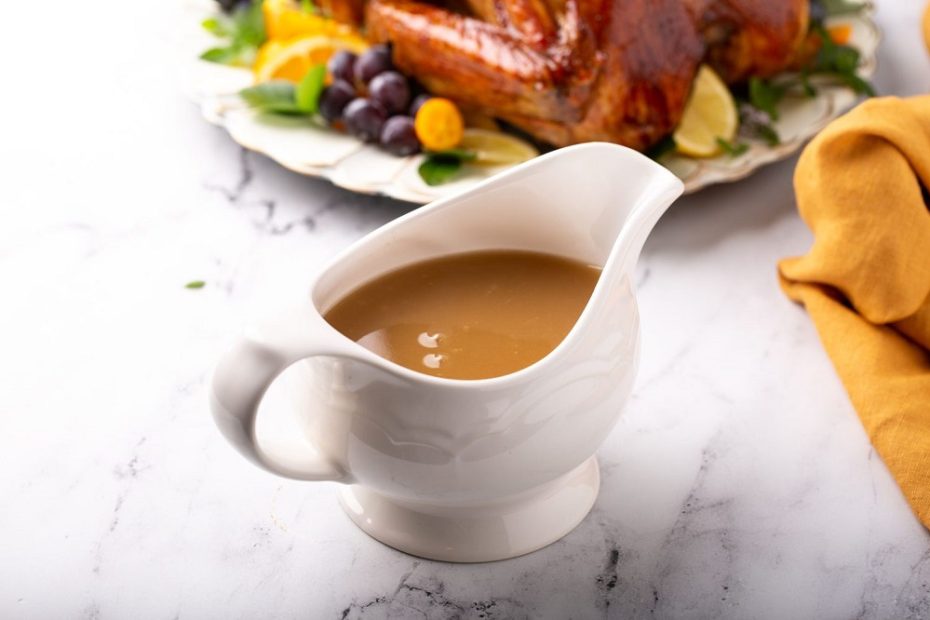When it comes to jar gravy, knowing its shelf life and proper storage is crucial to ensure both its freshness and safety. Whether you’ve already opened a jar or you’re considering purchasing one, understanding how long it can be stored and the signs of spoilage can help you make an informed decision.
Unopened jar gravy typically has a shelf life of up to one year. However, once you crack it open, storing it properly becomes essential to maintain its quality and avoid any potential health risks. So, how long can you keep an opened jar of gravy?
According to reliable sources, both canned and jarred gravy can last for up to one year in the pantry after being opened. The same applies if you decide to store it in the fridge. However, it’s important to note that homemade gravy and packaged gravy mix have different shelf lives.
Homemade gravy and packaged gravy mix should be kept at room temperature for no more than 2 hours. After that, it should be promptly refrigerated and consumed within 5-7 days. Once prepared, whether it’s meat-based or vegetable-based gravy, it should be consumed within the same timeframe of 5-7 days.
It’s worth mentioning that gravy usually has a “best before” date rather than an expiration date. While the quality may decline after this date, the gravy can still be safely consumed.
Contents
Key Takeaways:
- Jar gravy can last up to one year in the pantry or fridge once opened.
- Homemade gravy and packaged gravy mix should be consumed within 5-7 days after opening.
- Gravy has a “best before” date, but it can still be safely consumed after this date.
- Keep an eye out for signs of spoilage, such as changes in color, texture, and clarity.
- Proper storage, including refrigeration in an airtight container, helps maintain the freshness and safety of the gravy.
How Long Is Jar Gravy Good For After Opening?
According to the USDA, gravy can be safely stored in the refrigerator for three to four days after opening. Gravy can also be frozen for four to six months.
To store gravy, pour it into an airtight container and cool it down within two hours of cooking. If the gravy smells sour or is overly slimy, it has likely gone bad and should be thrown out.
For best quality, gravy should be consumed by the “Best If Used By” or “Use By” date stamped on the label or package.
Signs of Spoilage in Gravy
When it comes to gravy, visual cues are key to identifying spoilage signs. Changes in color, texture, and clarity can indicate that the gravy has gone bad. Here are some specific signs to watch out for:
- Separation: If you notice that the top of the gravy has become watery while the bottom has become firmer, it’s a clear indication of separation. This change in consistency might be a sign that the gravy is no longer good.
- Bad Smell: Meat-based gravies can develop a pungent odor when the meat juices start to spoil. On the other hand, vegetable-based gravies may last slightly longer before developing an off smell.
- Mold: Moist gravy can become a breeding ground for mold, especially if stored improperly. The presence of mold is a surefire sign of spoilage and consuming moldy gravy can pose serious health risks.
Proper food safety practices, such as maintaining good hygiene and being vigilant about changes in the gravy’s appearance, are crucial in preventing foodborne illnesses. Remember to trust your senses and err on the side of caution when it comes to consuming gravy that shows any signs of spoilage.
Proper Storage of Gravy
Proper storage plays a crucial role in maintaining the freshness and safety of both unopened and opened gravy. By following the appropriate storage techniques, you can extend the shelf life of gravy and ensure its deliciousness in your meals.
For unopened gravy: It is best to store unopened gravy in its original airtight container. This container is specifically designed to preserve the quality and flavor of the gravy. Find a cool, dark place in your pantry to store the unopened gravy. This will prevent exposure to excessive heat and light, which can lead to the deterioration of the gravy. By storing unopened gravy properly, you can enjoy its full flavor and quality for a longer period of time before opening.
For opened gravy: Once you’ve opened the jar of gravy, transfer any leftovers into an airtight container. This will help maintain the freshness and prevent spoilage. Refrigerate the container with the opened gravy promptly to minimize the growth of bacteria. The cold temperature of the refrigerator slows down bacterial growth and helps preserve the quality of the gravy. Remember to label the container with the date of opening to ensure you consume the gravy within the recommended time frame.
Freezing gravy: Freezing gravy is an option if you have a large quantity that you won’t be able to consume within a few days. However, it’s important to note that the quality of the gravy may decline after freezing. To freeze gravy, transfer it to a freezer-safe container, leaving enough headspace for expansion. You can freeze gravy for up to 3 months, but for the best taste and texture, it’s advisable to consume it within this time frame.
Proper Storage Tips:
- Store unopened gravy in its original airtight container in a cool, dark pantry.
- Transfer opened gravy to an airtight container and refrigerate promptly.
- Label the container with the date of opening.
- Freeze gravy in a freezer-safe container for up to 3 months, but consume it within that time frame for optimal quality.
| Storage Method | Shelf Life |
|---|---|
| Unopened Gravy | Up to 1 year in the pantry |
| Opened Gravy | 5-7 days in the refrigerator |
| Frozen Gravy | Up to 3 months in the freezer |
Shelf Life of Gravy when Prepared
When it comes to prepared gravy, the shelf life can vary depending on the type of gravy and the protein used. Both meat-based and vegetable-based gravies have their own shelf life estimates that should be taken into consideration.
Meat-based Gravy
Meat-based gravies, such as those made with beef, chicken, pork, or turkey, can have a shelf life of 2-3 years when stored in a pantry. This assumes that the gravy is properly prepared, stored in airtight containers, and kept in a cool, dark place.
Vegetable-based Gravy
On the other hand, vegetable-based gravies can also have a shelf life of 2-3 years when prepared correctly and stored in ideal conditions. It’s important to note that vegetable-based gravies may have a slightly longer shelf life compared to meat-based gravies.
However, it is crucial to remember that these shelf life estimates are for unopened gravy. Once the gravy has been opened, it should be handled as described in Section 1 of this article. The shelf life of opened gravy is typically 2 hours at room temperature and 5-7 days when refrigerated.
So, the shelf life of prepared gravy can vary based on the type of gravy and protein used. Both meat-based and vegetable-based gravies can last for 2-3 years when stored properly. However, it is important to adhere to the recommended shelf life for opened gravy to ensure safety and maintain the quality of the gravy.
Guidelines from Food Safety Organizations
The information provided in this article is based on the guidelines and research from reputable sources, including the United States Department of Agriculture (USDA) and the United States Food & Drug Administration (FDA). These organizations provide valuable resources for determining the shelf life of various foods, including gravy. It is important to note that individual cases may vary, and it is advisable to use personal judgment and consult a healthcare professional for specific concerns.
Conclusion
In conclusion, ensuring the proper storage and understanding the shelf life of jar gravy is crucial for safe consumption and food safety. The shelf life can vary depending on the type of gravy, whether it is canned, homemade, or a packaged mix. Additionally, the storage method, such as unopened or opened, refrigerated, or frozen, also plays a significant role.
For unopened gravy, it is best to store it in a cool, dark place, such as a pantry, to maintain its quality. Once opened, it is important to transfer the gravy to an airtight container and refrigerate it promptly. By following these storage guidelines, you can prevent spoilage and ensure the gravy remains safe to consume.
Monitoring the gravy for spoilage signs, such as changes in color, texture, or the presence of mold, is crucial for food safety. If any signs of spoilage are detected, it is best to discard the gravy. Remember, proper food safety techniques, such as practicing good hygiene and using the gravy within the recommended shelf life, are essential to prevent foodborne illness.
Remember, while this article provides general guidelines, it is always important to trust your own judgment and consult experts when in doubt. By following proper storage practices, monitoring for spoilage signs, and using the gravy within its recommended shelf life, you can enjoy delicious and safe gravy with your meals.
Source Links
- https://eatbydate.com/other/condiments/how-long-does-gravy-last/
- https://www.marthastewart.com/8179866/how-long-gravy-lasts-refrigerator
- https://www.brafb.org/wp-content/uploads/2016/01/Food-Code-Expiration-Extensions-.pdf





